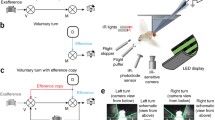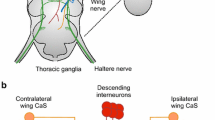Summary
In the flight simulator the optomotor response ofDrosophila melanogaster does not operate as a simple feedback loop. Reafferent and exafferent motion stimuli are processed differently. Under open-loop conditions responses to motion are weaker than under closed-loop conditions. It takes the fly less than 100 ms to distinguish reafferent from exafferent motion. In closed-loop conditions, flies constantly generate torque fluctuations leading to small-angle oscillations of the panorama. This reafferent motion stimulus facilitates the response to exafferent motion but does not itself elicit optomotor responses. Reafference control appears to be directionally selective: while a displacement of the patternm by as little as 0.1° against the ‘expected’ direction leads to a fast syndirectional torque response, displacements in the ‘expected’ direction have no comparable effect. Based on the behavior of the mutantrol sol, which under open-loop conditions is directionally motion-blind but in closed-loop conditions still performs optomotor balance, a model is proposed in which the fly's endogenous torque fluctuations are an essential part of the course control process. It is argued that the model may also account for wild type optomotor balance in the flight simulator.
Similar content being viewed by others
References
Batschelet E (1981) Circular statistics in biology. In: Sibson R, Cohen JE (eds) Mathematics in biology. Academic, London
Bausenwein B, Wolf R, Heisenberg M (1986) Genetic dissection of optomotor behavior inDrosophila melanogaster. Studies on wildtype and the mutantoptomotor-blind H31. J Neurogen 3:87–109
Brun R (1914) Die Raumorientierung der Ameisen und das Orientierungsproblem im allgemeinen. Gustav Fischer, Jena
Buchner E (1976) Elementary movement detectors in an insect visual system. Biol Cybern 24:85–101
Götz KG (1964) Optomotorische Untersuchung des visuellen Systems einiger Augenmutanten der FruchtfliegeDrosophila. Kybernetik 2:77–92
Götz KG (1980) Visual guidance inDrosophila. In: Siddiqi O, Babu P, Hall LM, Hall JC (eds) Development and neurobiology ofDrosophila. Plenum, New York, pp 391–407
Götz KG (1983) Genetik und Ontogenie des Verhaltens. Genetischer Abbau der visuellen Orientierung beiDrosophila. Verh Dtsch Zool Ges 1983:83–99
Götz KG, Buchner E (1978) Evidence for one-way movement detection in the visual system ofDrosophila. Biol Cybern 31:243–248
Hausen K (1981) Monocular and binocular computation of motion in the lobula plate of the fly. Verh Dtsch Zool Ges 1981:49–70
Heisenberg M (1983) Initiale Aktivität und Willkürverhalten bei Tieren. Naturwissenschaften 70:70–78
Heisenberg M, Wolf R (1979) On the fine structure of yaw torque in visual flight orientation ofDrosophila melanogaster. J Comp Physiol 130:113–130
Heisenberg M, Wolf R (1984) Vision inDrosophila. Genetics of micro-behavior. In: Braitenberg V (ed) Studies of brain function, vol. XII. Springer, Berlin Heidelberg New York
Holst E von, Mittelstaedt H (1950) Das Reafferenzprinzip. Wechselwirkungen zwischen Zentralnervensystem und Peripherie. Naturwissenschaften 37:464–476
Kühn A (1919) Die Orientierung der Tiere im Raum. Fischer, Jena
Mayer M, Vogtmann K, Bausenwein B, Wolf R, Heisenberg M (1988)Drosophila flight control during ‘free yaw turns’. J Comp Physiol A 163:389–399
Mittelstaedt H (1951) Zur Analyse physiologischer Regelungs-systeme. Verh Dtsch Zool Ges, Zool Anz [Suppl]:150
Poggio T, Reichardt W (1973) A theory of the pattern induced flight orientation of the flyMusca domestica. Kybernetik 12:185–203
Rádl EM (1903) Untersuchungen über den Phototropismus der Tiere. Engelmann, Leipzig
Reichardt W (1970) The insect eye as a model for analysis of uptake, transduction and processing of optical data in the nervous system. In: Schmitt FO (ed) The neurosciences. Second study program. Rockefeller University Press, New York, pp 494–511
Reichardt W (1973) Musterinduzierte Flugorientierung der FliegeMusca domestica. Naturwissenschaften 60:122–138
Reichardt W, Poggio T (1976) Visual control of orientation behaviour in the fly. Part I. A quantitative analysis. Q Rev Biophys 9:311–375
Reichardt W, Wenking H (1969) Optical detection and fixation of objects by fixed flying flies. Naturwissenschaften 56:424–425
Sperry RW (1950) Neural basis of the spontaneous optokinetic response produced by visual inversion. J Comp Physiol Psychol 43:482–499
Wolf R, Heisenberg M (1986) Visual orientation in motion-blind flies is an operant behaviour. Nature 323:154–156
Author information
Authors and Affiliations
Rights and permissions
About this article
Cite this article
Heisenberg, M., Wolf, R. Reafferent control of optomotor yaw torque inDrosophila melanogaster . J. Comp. Physiol. 163, 373–388 (1988). https://doi.org/10.1007/BF00604013
Accepted:
Issue Date:
DOI: https://doi.org/10.1007/BF00604013




